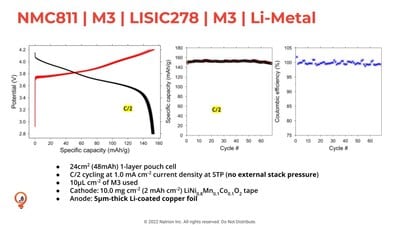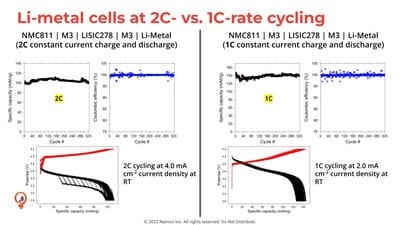Natrion Demonstrates Solid-State Feasibility Of Lithium EV Battery Cells
Natrion, a pioneering firm in the realm of solid-state electric vehicle battery technology, recently disclosed performance data of its patented compounds utilized in lithium-metal anode pouch cells. The results marked a significant progression in the commercial feasibility of solid-state Li-metal batteries, demonstrating high C-rate capability and extensive cycle life, intriguingly, without the reliance on stack pressure. This new data not only highlights a major breakthrough for Natrion but also contributes substantively to the ever-growing body of research that assesses the practicality of solid-state batteries (SSBs) for implementation in electric vehicles (EVs).

In an earlier round of testing, Natrion had demonstrated the superior performance of its proprietary material, LISIC278, in standard pouch cells employing graphite anodes. This time, however, the team opted for a newer approach. They fabricated new coin cells and pouch cells using a LISIC278 solid-state electrolyte separator paired with a lithium-metal anode. The latter was composed of a 5-micrometer-thick lithium coating on copper foil. In addition, Natrion introduced their latest innovation, a solid electrolyte interphase (SEI)-forming wetting agent named M3. This agent is designed to stabilize the Li-metal, suppress dendrite formation, and enable cycling at high coulombic efficiency – all without the requirement for external stack pressure on the cell. This represents another major stride towards the commercial viability of solid-state batteries in electric vehicles.
These tests showed:
- Near-zero fire risk
- 50%+ greater energy density vs state-of-the-art graphite anode due to improved volumetric and gravimetric efficiency (reduced total cell stack thickness)
- High cycle life and C-rate capability: 320 cycles demonstrated at 2C (30 min charge time) and 100% depth-of-discharge with 98% retention
- 420 to 450 miles of potential range on a single charge in an EV application, for a total of 145,000+ driving miles without loss of performance
- Viability to deliver these metrics without the use of stack pressure due to M3
Natrion’s groundbreaking data may represent the first and only known instance of achieving high cycle life and high C-rate without the necessity for additional stack pressure in the realm of solid-state battery technology. Prior to this, it is unclear if any entity had been able to prove this set of conditions. Several industry players have indeed demonstrated high cyclability, a critical factor in the commercial viability of batteries. However, such results have usually come at the cost of a much longer charging time or the application of significant external pressure. These trade-offs have posed considerable challenges to the widespread adoption of solid-state batteries in electric vehicles. Hence, Natrion’s advancements could potentially herald a paradigm shift in the battery technology landscape.
The groundbreaking nature of Natrion’s achievement cannot be overstated. Achieving these outcomes without necessitating stack pressure on the cell is a significant leap forward. Applying stack pressure calls for the integration of an external device, effectively negating any energy density gains from cell chemistry. While it’s feasible to apply pressure to an individual battery cell in a testing environment, engineering this pressure into a battery pack is a highly complex task. Hence, Natrion’s innovation stands out as potentially the first commercially viable solution to this daunting engineering challenge, paving the way for its application in electric vehicles. This could very well mark a new chapter in the evolution of battery technology for EV applications, propelling the industry towards a more sustainable and efficient future.
“These metrics prove that Natrion’s LISIC and M3 electrolyte solutions can lead to the advent of high energy density Li-metal cells that are highly scalable and can be very readily produced at high volume,” said Alex Kosyakov, Natrion cofounder and CEO. “The benefit of LISIC over other electrolyte solutions is that we can still use roll-to-roll high-throughput manufacturing processes and established cell construction techniques. This, combined with a lack of need for stack pressure to accomplish high performance, makes us believe that we have a real opportunity to be the ones to finally deliver Li-metal cell technology to mass market EVs.”

